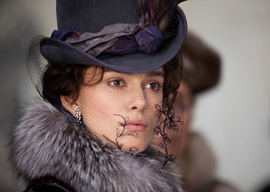
November 21, 2012

Keira Knightley
First, I”ve seen many a Keira Knightley movie over the years and had come to assume that the bony beauty from Pirates of the Caribbean must have hit her ceiling as an actress. Yet her surprisingly strong performance as the adulterous aristocrat is a reminder that she’s still only 27 and may have the best of her oeuvre ahead of her. She looks great in Muscovite fashions, too, often sporting a transparent veil that casts a softening shadow on her imposing jawline.
Second, Wright’s pictorial flair is close to overwhelming, reminiscent of Baz Luhrman‘s in his 2001 Moulin Rouge. Luhrman’s similarly supercharged adaptation of The Great Gatsby, with Knightley’s friend and rival Carey Mulligan as the unfaithful Daisy Buchanan, was racing Wright’s Anna Karenina to the screen but has now been postponed to next year.
Wright’s movie might have benefited from coming out at a different time of the year, too, because the Christmas deluge of perfume ads on television dilutes the impact of his jewel-box visuals. (Here’s Wright’s recent Chanel No. 5 ad with Knightley.)
After receiving Stoppard’s script, Wright, who grew up at his parents” London puppet theater, came up with the Stoppardian idea of setting his film within a theater. Wright’s notion of portraying aristocratic family life as actual public spectacle is promising, but he didn”t get Stoppard to help him develop it much, so it remains half-baked. Yet even though Wright often appears to have art-directed himself into another lavishly decorated corner, he constantly comes up with segues of near-genius to keep his hyper-ambitious movie moving.
Wright’s Anna Karenina is not by any means a filmed play. Instead, it’s metaphor literalized, as the aristocratic characters play out their private lives on stages made painfully public by omnipresent observers gossiping about them.
Third and most remarkably, Wright’s film may be the first of the numerous Anna Karenina adaptations whose sympathies lie firmly with her cuckolded husband, the unsexy bureaucrat Karenin.
For example, in Vivien Leigh’s 1948 Anna, Ralph Richardson played the husband as a stuffed shirt. But Jude Law (who is transitioning gracefully from not-quite-a-leading-man into a major character actor) gets to portray Karenin as a hero. Law’s Karenin is the type of competent public servant who has been all too rare in Russia’s unfortunate history.
Interestingly, in 2008 Wright broke off his engagement to actress Rosamund Pike (who played Jane in Wright’s Pride and Prejudice) ostensibly because she sent out wedding announcements he found distasteful. Whether this scandal has anything to do with the patriarchal bias of Wright’s Anna Karenina is unknown but intriguing.
Today it’s universally assumed that an unfaithful wife should get custody of the children. Yet Wright and Stoppard don”t seem terribly interested in pointing fingers at 19th-century Russians for their lack of enlightenment about family law.
When Anna laments that she can”t possess both her lover and her son because “The laws are made by husbands and fathers,” it’s hard not to respond, “As well they should be.” Wright’s film depicts the staggering amount of wealth piled up in Imperial Russia by aristocratic families”much of it spent by women on fashion. But all of this acquiring and saving depended on an orderly system of inheritance where men knew that their heirs really are theirs.